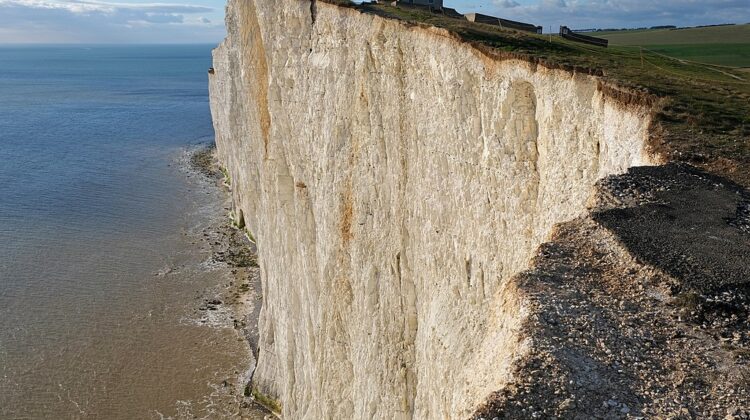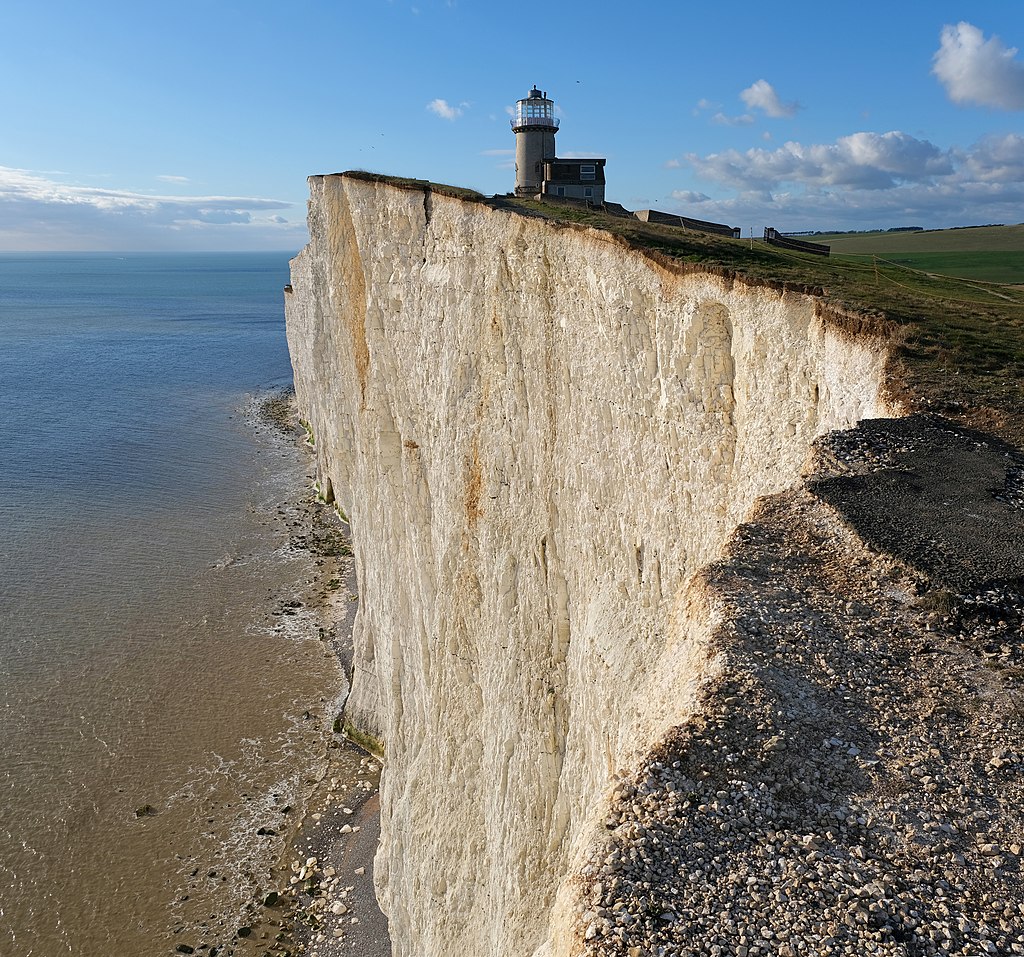
The Belle Tout Lighthouse, also spelled Belle Toute, is a decommissioned lighthouse and British landmark located at Beachy Head, East Sussex, close to the town of Eastbourne. It has been called “Britain’s most famous inhabited lighthouse” because of its striking location and its use in film and television. The Grade II listed building was moved in one piece in 1999 to prevent it from succumbing to coastal erosion.

History
Construction
The cliffs near Beachy Head saw numerous shipwrecks in the 17th and early 18th centuries, and a petition to erect a lighthouse began around 1691. However, the calls were ignored for over 100 years until The Thames, an East Indiaman, crashed into the rocks off Beachy Head.
The petition gained momentum with the support of a Captain of the Royal Navy, and Trinity House, the official lighthouse authority, agreed to attend to the matter. Having witnessed the incident himself, John ‘Mad Jack’ Fuller, MP for Sussex, used his influence and personal wealth to fund the lighthouse’s construction. The first Belle Tout lighthouse was a temporary wooden structure that started service on 1 October 1828. It displayed a revolving light, which exhibited ‘its greatest brilliancy once in two minutes.’
The construction of the permanent granite lighthouse began in 1829 to a design by Thomas Stevenson, and it became operational on 11 October 1834. The light was provided by a three-sided rotating array of oil lamps, with ten lamps on each side, each mounted within a parabolic reflector. Its use of 30 oil lamps meant that the lighthouse required two gallons of oil every hour.
In 1887, the light was altered and equipped with the latest Douglass two-wick oil burners: six lamps and reflectors on each side of a clockwork-driven revolving triangular frame (eighteen lamps in total). The speed of rotation was significantly increased to give a four-second flash every fifteen seconds.
Decommission and sale

The Belle Tout Lighthouse, also spelled Belle Toute, was not as successful as hoped due to two significant flaws, leading to the search for an alternative. The cliff-top location caused problems when sea mists obscured the light, significantly reducing its reach, and vessels that sailed too close to the rocks could not see the light because it was blocked by the cliff’s edge.
However, the cliffs of Beachy Head suffered intense coastal erosion over the years, and the rocky area began to be covered by the light. The Belle Tout remained in service until 2 October 1902, when a new lighthouse was built at the bottom of the cliffs, known simply as the Beachy Head Lighthouse. Trinity House sold off the building in 1903, after which it changed hands several times. One purchaser, Sir James Purves-Stewart, constructed an access road and upgraded the building.
During the Second World War, the building was left empty and was badly damaged by Canadian artillery fire. Although the lighthouse itself was not the target, the guns were firing at wooden silhouettes of tanks that ran up the hill along rails to the east of the building. The trace of the railway track is still discernible.
After the local council took ownership in 1948, they decided to restore the lighthouse because of its historical significance. The ground floor of Stevenson’s adjoining cottage was restored, and its ruined first floor was replaced with a new piano nobile, designed and built by Ted Cullinan. Building work was carried out under a lease in 1956, and the lighthouse was brought up to date with modern amenities.
In 1986, the BBC purchased the lease to Belle Tout for the filming of the mini-series The Life and Loves of a She-Devil, and a year later, it featured in the James Bond film The Living Daylights. From 1996, the lighthouse was used as a family home, and in 2007, the building was put up for sale again. It now includes six bedrooms and large walled gardens.
The lighthouse was further immortalised in the song “Belle Tout” by British rock band Subterraneans and in the movie B Monkey, starring Asia Argento. The glass “round room,” which once housed the light itself, was featured on the popular BBC television show Changing Rooms, where it was redesigned by celebrity interior designer Laurence Llewelyn-Bowen.
Coastal erosion
The erosion of the cliffs had threatened the foundations of the Belle Tout lighthouse by 1999, and drastic steps had to be taken to prevent it from falling into the sea. On March 17, 1999, the lighthouse was moved 17 meters (56 feet) away from the cliff face.
To move the 850-ton building, a pioneering system of hydraulic jacks was used. The system pushed the lighthouse along four steel-topped concrete beams that were constantly lubricated with grease. The work was carried out by the engineering firm Abbey Pynford.
The site is now safe for many years and has been designed to enable further moves as and when they are required.

Belle Toute Lighthouse Preservation Trust

The “Belle Tout Lighthouse Preservation Trust” was formed in 2007 with the aim of creating a non-profit organisation that could raise the funds required to purchase the lighthouse, and to open it as a tourist attraction and bed and breakfast. However, the trust was wound up in May 2008.

Restoration and conversion to a bed and breakfast
In January 2010, the lighthouse was featured on Channel 5 in a programme called “Build a New Life in the Country”, which showcased its purchase in 2008 and conversion into a luxury bed and breakfast.
Belle Tout lighthouse was purchased for £500,000 and an additional £700,000 was spent on its restoration. The original access road was located too close to the cliff’s edge, and negotiations with the local council were required to pay an easement fee to construct a new road.

I appreciate you sharing this blog post. Thanks Again. Cool.
I just like the helpful information you provide in your articles
I just like the helpful information you provide in your articles
I just like the helpful information you provide in your articles
Love your perspective, such a refreshing read!